Dullna Bhoj Sabzi


Dullna Boj Sabzi
Dullna is traditionally prepared in Mithilanchal in Bihar. This sabzi is made with mixed vegetables like raw banana, parwal, pumpkin, potatoes, brown soaked chana, etc. Dullna is made without onion and garlic.
When their is special occasion in village of mithila and hundred of people are invited for the food dullna is one of the dish which is prepared during such occasions. Seasonal vegetables are used in dalna. Dullna is prepared in two variations according to season. In winters dalna is prepared with vegetables like cauliflower, potatoes, green peas, pumpkin, tomatoes, etc. In summer parwal, pumpkin, potatoes, raw banana, jackfruit, etc are mostly used to make sabzi.
Dullna Method:
- Remove skin of 4 raw bananas with the help of knife and cut it into big pieces.
- Cut 250 gms pumpkin into big pieces.
- Scrub 5-6 parwal and cut it into 2 parts vertically.
- Now peel 3 potatoes and cut into big pieces.
- Wash all the vegetables and drain water out.
- Heat 2-3 tablespoon oil in kadhai and slightly fry all vegetables one by one and keep aside. First parwal then banana, pumpkin and finally potatoes.
- Now in the same left over oil put 1/2 teaspoon cumin seeds.
- Once it starts cracking add 2 bayleaf, 1 dry chilly and asofodita.
- Take inch of ginger, wash and crush it and put it in the kadhai.
- Now put all slightly fried vegetables in the kadhai.
- Put 1/2 teaspoon turmeric powder and salt to taste.
- Cover the vegetables and allow it to cook for 5-10 minutes. Stir in between once to avoid burning of vegetables and cover again.
- Now remove the cover and stir vegetables. Put 2 teaspoon coriander powder, 1/2 teaspoon red chilly powder and mix.
- Put some oil if required and then put 1 tablespoon garam masala powder.
- Stir vegetables and let it cook for 1 minute.
- Now add 1 1/2 glass water in it and cover the sabzi again.
- Cook the sabzi for more 10 minutes.
- Remove the cover and check whether sabzi is cooked properly else cook it for more time.
- Once sabzi (dalna) is cooked switch off the flame.
- Take 1 tablespoon ghee or oil for tadka. Heat ghee or oil and add 1/4 teaspoon cumin seeds.
- Once it starts cracking add asofodita and put the tadka to sabzi.
- Dalna is ready to be served. It goes well with puries.
Moong Dal Urad Dal Methi Pakode


Moong Dal Urad Dal Methi Pakode
We love to eat fried items during rains specially pakodas with hot tea.
There are varieties of pakodas mirch (chilly) pakoda, makai (corn) pakoda, kanda (onion) pakoda, leafy vegetable pakoda, panner (cottage cheese) pakoda and many more.
In dal pakodas also we have varieties of dal pakodas. Below mentioned pakoda recipe is of moong dal and urad dal pakoda with methi leaves.
These pakodas are crisp from outside and fluffy from inside so try out this recipe and enjoy these pakodas in monsoon.
Method:
- Soak 3 handful of moong dal and 3 handful of black urad dal in water overnight.
- Now wash the dal and grind it to smooth paste without water.
- Take the grinded mixture in bowl and put 3-4 finely chopped green chillies in it.
- Put 5-6 finely chopped garlic cloves in it without skin.
- Put small piece of finely chopped ginger approx 1/2 inch.
- Wash 3 handful fenugreek (methi) leaves and chop it.
- Put methi leaves into the grinded dal.
- Add 1 tablespoon crushed black pepper and salt to taste.
- Now beat the mixture for 5-10 minutes so that it will turn soft from inside.
- Heat oil in kadai for frying moong dal urad dal methi pakode.
- Once oil is heated take small portion of dal batter and shape pakodas in hot oil.
- Fry moong dal urad dal methi pakode on low to medium flame.
- Serve pakodas with chutney.
Stuffed Baby Bitter Gourd (Karela Bharwa)

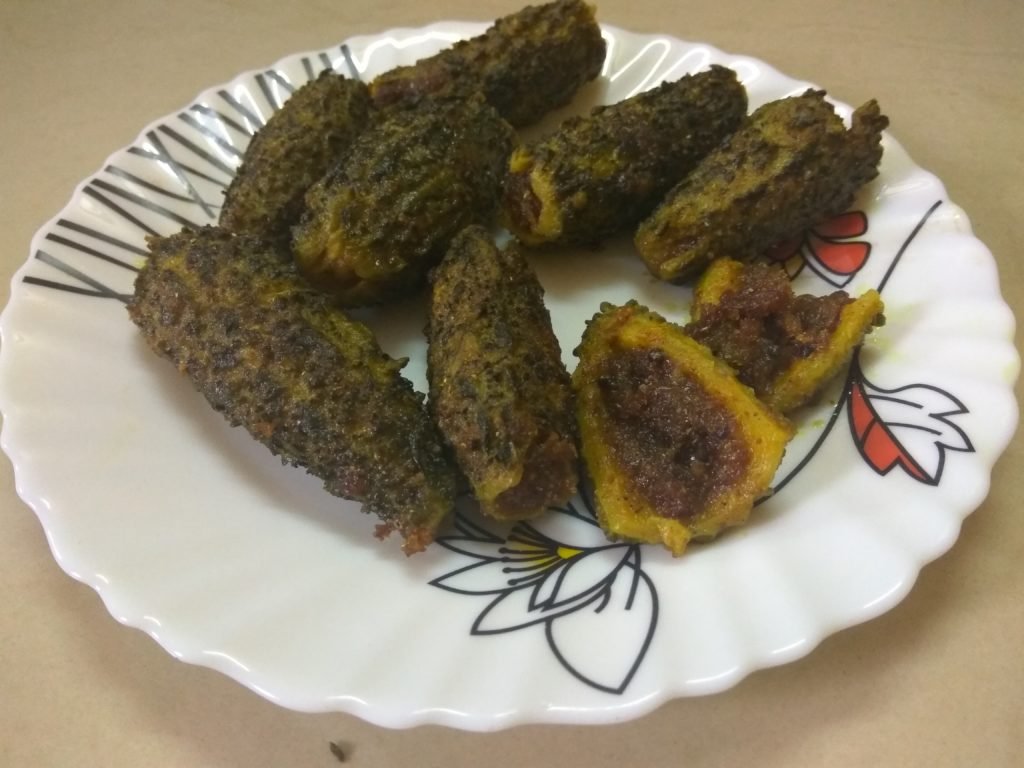
Stuffed Bitter Gourd
Bharta or bharwa is basically vegetables stuffed with masala. Vegetables like Brinjal, Parwal, Ladies Finger (Okra), Bitter Gourd are used for bharwa / Bharta. Bitter Gourd (Karela) is bitter in taste but still loved by many people. Few people love its taste and few prefer eating karela due to its medicinal properties. Bitter gourd is used for making curry, fries, chips, bharta and achaar.
Many people are adviced to drink karela juice.
Method To Make Karela Bharta / Karela Bharta:
I have 7-8 baby bitter gourds which I will boil and then stuff with masala and then shallow fry. Instead of baby karela (Bitter Gourd) you can use large karelas as it will be easier to stuff masala inside.
- Wash and boil 7-8 karelas with little salt till soft.
- Now with the help of knife slowly remove all seeds inside all karelas (bitter gourd) by inserting knife inside it.
- Peal 1 1/2 onion and wash.
- Remove skin of 5-6 garlic cloves.
- Now roughly grind onion,garlic and small piece of ginger to rough paste.
- If your using large karelas so you will require more masala so double the quantity accordingly.
- Heat 2-3 tablespoon oil in kadai or pan.
- Put pinch of cumin seeds.
- Once cumin starts cracking add chopped onion-garlic paste and stir continously till onion is fried nicely and oil starts separating from onion.
- Put 1/2 teaspoon turmeric powder, 1 teaspoon coriander powder and 1/4 teaspoon red chilly powder and mix.
- Now add 1 1/2 tablespoon garam masala powder and stir again.
Put salt to taste and stir for 1 minute and switch of the flame. - Once masala cools down stuff all karelas with masala with help of your finger.
- Now heat oil in pan for shallow frying karelas.
- Put stuffed baby karelas one by one and shallow fry karelas (bitter gourd) on low flame.
- Fry karelas from all the sides carefully. As karelas are already boiled they will not take much time to be fried.
- Switch off the flame and remove fried karelas in a plate. It can be served with dal rice or chapaties.
Mattar Paneer


Mattar Paneer
Mattar Paneer is North Indian recipe made with green peas and cottage cheese. Green peas is called as mattar in Hindi and cottage cheese as paneer. North Indian cuisine consist of varieties of popular paneer recipes among which is mattar paneer. Paneer is good option for vegetarians mostly in restaurants or wedding or any other occasions as they don’t eat chicken.
How To Make Mattar Paneer:
- Wash and boil 300 gm mattar (green peas) till soft.
- Cut 300 gms paneer (cottage cheese) into square shape pieces.
- Chop onions and tomatoes.
- Heat 3 tablespoon oil in kadai.
- Put 1/2 tablespoon cumin seeds.
- Once cumin seeds starts cracking add chopped onions and stir.
- Put pinch of salt and cook onion till soft. Salt helps in cooking onion fast.
- Now when onion turns soft add 1 tablespoon ginger-garlic paste.
- Cook till raw aroma of ginger-garlic goes out.
- Add chopped tomatoes and cook till soft in mashable format.
- Add 1/2 teaspoon turmeric powder, 2 teaspoon coriander powder and 1/2 teaspoon red chilly powder.
- Cook masala for 1 minute.
- Now add boiled mattar (green peas) and stir.
- Put salt to taste and 1 1/2 tablespoon garam masala powder.
- Put 2 cups water and give it a stir.
- Now add paneer (cottage cheese) pieces and fresh chopped coriander leaves.
- Allow it to cook for 5 minutes and then put 1/2 cup milk.
- Cook mattar paneer for more 10-15 minutes on low to medium flame.
- Mattar paneer is ready. Switch off the flame.
Kadai Corn And Paneer
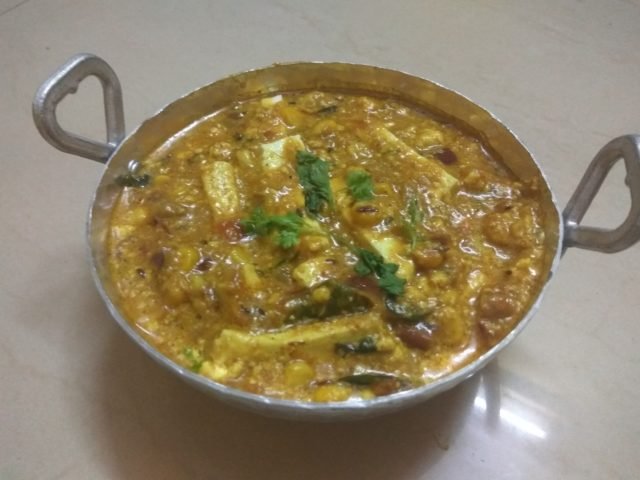

Kadai Corn And Paneer
Method:
- Remove corns, keep 2-3 tablespoon corns aside and boil rest corns in water.
Finely chop one large onion and 2 small size tomatoes. - Remove 5-6 garlic skin and grind it with piece of ginger.
- Wash and take 2-3 tablespoon corns into grinder and grind it to smooth paste. Don’t use more corns for grinding only 2-3 tablespoon.
- Heat 2-3 tablespoon oil in kadai.
- Put 1/2 teaspoon cumin seeds.
- Once cumin seeds starts cracking add curry leaves.
- Now add chopped onion and cook till onion turns soft.
- As soon as onion turns soft put garlic-ginger paste and stir till raw aroma of garlic ginger goes out.
- Now add corn paste and stir continously 2 minutes.
- Put two green chilly slits without seeds.
- Put 2 chopped tomatoes and cook till tomatoes turn soft.
- Now add boiled corns and mix.
Cook for 5 minutes and add 1/2 teaspoon turmeric powder, 1/2 teaspoon coriander powder and stir. - Put 2 tablespoon garam masala powder and stir again. If required put some oil and mix.
- Put salt as per your taste.
- Now cut piece of paneer and cut it into few thin stipes approx 6-7.
- Break rest paneer roughly with your hand and put it to the gravy. Stir for more 2 minutes.
- Put 3/4 to 1 glass of water and allow it to cook.
- Once it gravy starts simmering put paneer strips and give it a gentle stir.
- Let it cook for more 1 minute on low flame.
- Kadai corn and paneer is ready to be served. Garnish it with few chopped coriander leaves.

Makai Aur Paneer Ki Sabzi
Airkanchan Jhor (Taro Leaves Curry)
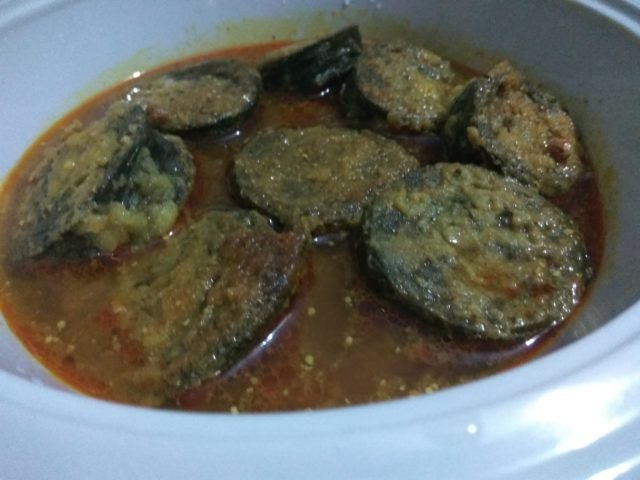

Airkanchan (Taro Leaves Curry)
Taro Leaves similar to Colocasia Leaves are used to make curry in Mithilanchal in Bihar. This dish is made in almost every house of maithils and is very tasty with its unique flavors that comes out with combination of taro leaves, urad dal paste, mustard paste and spices altogether.
Airkanchan is not very well known recipe but similar to Patra and Alu Vadi recipes prepared in Maharashtra and Gujarat. Difference is Patra and Alu Vadi is just fried with masala and served as snack whereas Airkanchan after frying is cooked into curry. Use of masala and coating is also different Patra and Alu Vadi uses gram flour for coating whereas for Airkanchan urad dal (black dal) paste is used so altogether a different taste but both are tasty.
Colocasia and Taro Leaves belongs to the same family. Colocasia stems are dark in color whereas taro leaves stems are lighter in color. Colocasia leaves are called as alu vadi leaves in market and taro leaves are called as bhaji leaves. Colocasia leaves are large compare to taro leaves and taro leaves are little itchy compared to Colocasia leaves hence people use tamarind and lemon to reduce itchiness but curry is extremely delicious and you will just love it.
Preparation For Airkanchan Chakkas (Vadies):
- Soak 1/2 cup urad dal (black dal) in water for 3-4 hrs.
- Wash the dal properly and grind it into smooth paste.
- Cut the stems of 2-3 bunch of taro leaves and wash them properly.
- Place the biggest leaf at the bottom smooth side of leaf at bottom and rough side on the top.
- Apply urad dal (black dal) paste on the rough i.e top side of taro leaf.
- Now place another taro leaf on it and again apply the urad dal paste on top of this leaf.
- Simillarly start putting taro leaves one by one on top of each other with urad dal paste applied to each leaf.
- Fold the edges of the leaves horizontally and vertically and roll the leaves similar to Patra or Alu Vadi.
- Once you get nice long thick roll of taro leaves again apply urad dal paste to all the sides of roll.
- Now cut it into round pieces like Patra or Aloo vadi.

- Heat oil in kadai and shallow fry airkanchans from both the sides.
- Remove airkanchans from oil and keep it in plate.

Fried Airkanchan Chakka
For Airkanchan jhor (Curry):
- First prepare airkanchan curry masala.
- Take 1 tablespoon black mustard seeds and 1 tablespoon yellow mustard seeds or you can use 2 tablespoon yellow mustard seeds. Don’t use 2 tablespoon only black mustard seeds else curry might turn bitter.
- Now this mixture is grinded with little water on stone traditionally but you can use grinder instead don’t use water else it will not be grinded properly.
- Grind it without water into powder and then add little water (1/2 tablespoon) and mix to make a thick paste.
- Now take 3 tablespoon coriander powder and 1 tablespoon red chilly powder with 1/2 tablespoon water and gring it to a paste.
- Heat oil in a kadai.
- Add 1/4 teaspoon panch phoran.
Once it starts cracking add mustard paste and stir for one minute. - Now add coriander-chilly powder paste, 1/2 teaspoon turmeric powder and stir again.
- Cook spices for a while then add 3 cup water.
- Salt to taste and stir.
- Put tamarind water in the airkanchan (taro leaves) curry.
- Let curry boil. Once it starts boiling put airkanchan pieces one by one in the curry.
- Lower the gas flame let it cook for more 10-15 minutes.
- Airkanchan goes well with steamed rice. You can add little lemon juice before serving the curry.

Taro Leaves Curry
Anarsa Recipe


Anarsa
Anarsa is dessert prepared from rice, sugar, jaggery, ghee, oil, poppy seeds and milk. It is mostly prepared in Maharashtra and Bihar on festive occasions.
People make anarsa either with sugar or jaggery. I am using sugar in this anarsa recipe. If you prefer jaggery you can replace sugar with jaggery.
Anarsa Method:
- Clean, wash and soak 1 cup rice for three days.
- Change water of rice regularly.
On the third day again wash the rice and drain the water from rice. - Dry the rice under fan for 2-3 hours.
- Anarsa rice should be dried but it should have little moisture in it.
- Grind the rice into fine powder for anarsa.
- Now take the rice powder in a bowl, add 1/2 cup sugar in it.
- Add 2 tablespoon ghee in it and mix properly.
- Rub the mixture with your palm knead semi soft dough for anarsa without using water. If required you can add 2-3 tablespoon milk.
- Keep anarsa dough for overnight or 6-7 hours.
- Next day heat oil or ghee for frying anarsa.
- Anarsas will be shallow fried. I am using oil for frying you can use ghee also. 6-7 tablespoon ghee will be required.
- By the time oil is getting heated slightly knead anarsa dough again.
- Take small portion of anarsa dough in your hand, press it and flatten into 1/2 cm disc or puri shape.
- Put it on poppy seeds such that poppy seeds stick on one side of anarsa.
- As soon as oil is heated slowly drop the anarsa in oil such that side with poppy seed should appear on the top and other side of anarsa should be below in oil.
- Fry anarsa on low to medium heat one by one. Don’t flip the anarsa it should be fried from one side just keep putting hot oil or ghee on anarsa from all the sides.
- Repeat the process and fry all anarsas.
- Remove anarsas in a plate and switch off he flame.
- Anarsas are ready to be served.
Gulab Jamun Recipe

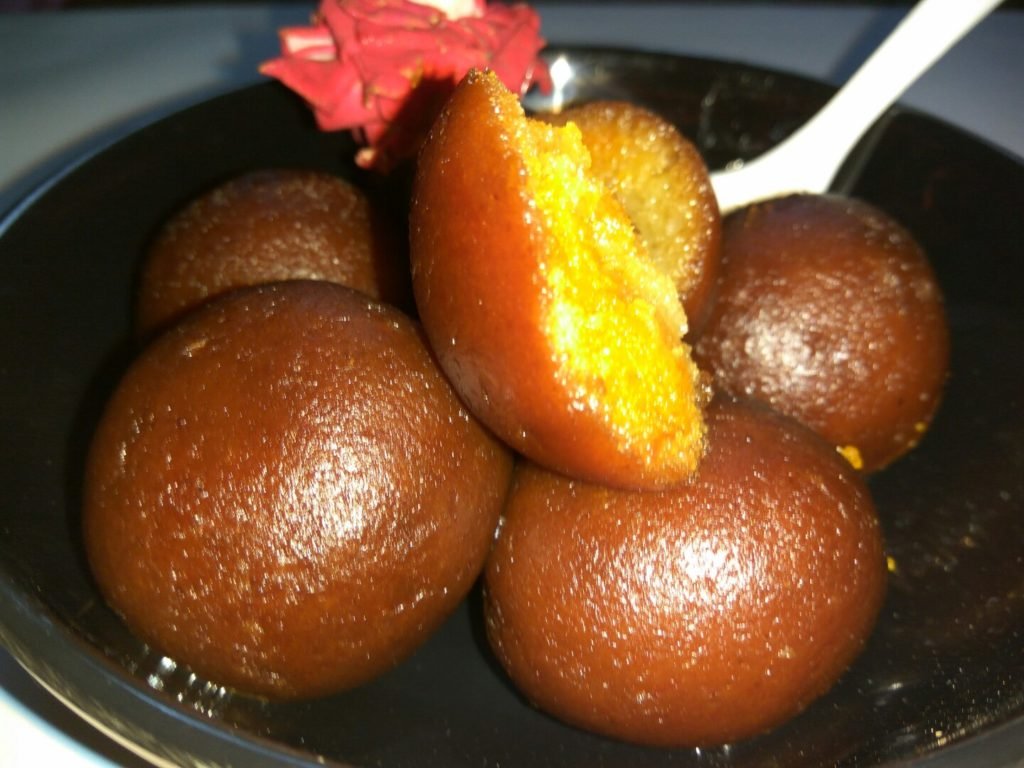
Gulab Jamun
Golden brown round balls soaked in nice flavored sugar syrup brings water in almost everyones mouth. Gulab jamun is all time favorite dessert in India. It is mostly served in parties and weddings. Gulab Jamun is made with khoya, paneer, milk powder, maida. It is also made with bread, semolina (rava). Few people love to eat gulab jamuns hot.
Sugar Syrup (Chasni) For Gulab Jamun:
- Take 3 cups sugar and 1 1/2 cup water in a vessel.
- Once sugar dissolves heat it. Allow it to boil till thin one string consistency or stickiness.
- Put juice of 1 lemon wedges to avoid crystallization of sugar syrup (chasni).
- Switch off the flame and allow the sugar syrup to cool down till room temperature.
- Take 1 teaspoon fennel seeds, 1/2 teaspoon black pepper and 5-6 green cardamon without skin in a grinder and grind it to rough powder.
- Put this grinded powder to the sugar syrup and mix.
Gulab Jamun Balls:
- Take 250 gm mawa (khoya), 100 gm paneer and 1/2 cup all purpose flour (maida) in a bowl and mix.
- Strech and knead the dough till soft if required add very little milk and knead soft dough. If dough becomes too soft add little maida and mix again.
- Take small portion of dough, apply ghee in your hand and roll it into round ball without any cracks. If cracks are there knead dough for more time.
- Apply ghee in your palm and shape round balls with gulab jamun dough.
- Heat oil in a kadai put gulab jamuns and fry from all the sides till golden light brown.
- Gulab jamuns get fried immediately so take care while frying so that it doesn’t burn.
- Remove all the fried gulab jamuns in a plate.
- Once it cools down at room temperature then put it into sugar syrup. Let it dipped for 8-10 hours for better result.
Mixed Vegetable Recipe Without Onion Garlic


Mixed Vegetable Recipe
This mixed vegetable recipe is without onion and garlic. In this recipe you can use variation in vegetables. Mostly vegetables used are carrots, cauliflower, french beans, paneer, capsicum, green peas, etc.
Mixed Vegetables Recipe:
- Cut 3 medium size carrots into 2 inch pieces.
- Simillarly cut 6-8 French beans into pieces.
- Peel a small potato and cut into pieces.
- We require 10-12 cauliflower florets and 1/4 cup soaked small brown chanas or fresh green peas.
Wash all vegetables nicely. - Now heat 2-3 tablespoon oil in a pan.
- Put 1/4 teaspoon cumin seeds. Once it starts cracking add 2 bayleaf, 1 dry red chilly and little asofodita.
- Now put the washed vegetables into the pan and stir.
- Put 1/4 teaspoon turmeric powder and mix.
- Cover the vegetables and let it cook for 10 minutes on low flame.
- After 10 minutes remove the cover and stir the vegetables.
- Add salt to taste little oil if required and again cover and cook for more 5 minutes.
- After 5 minutes remove the cover, stir the vegetables and add 1 teaspoon coriander powder and mix.
- Now put 1/2 teaspoon ginger paste and 1 teaspoon cumin powder.
- Add 1 tablespoon garam masala powder and mix.
- Give it a quick stir and add 3/4 glass water.
- Now add 1/4 glass milk and stir.
- Cover the vegetables and cook for more 5-10 minutes on medium flame.
- Remove the cover after 10 minutes and stir.
- Switch off the flame and serve mixed vegetables with chapati, roti or paratha.
Aloo Baingan Palak Ki Sabji
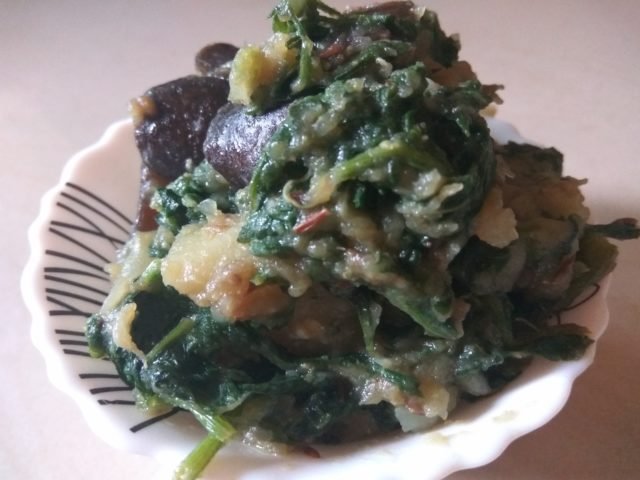

Aloo Baingan Palak Ki Sabji
Aloo Baingan Palak Ki Sabji (Potatoe Eggplant Spinach Dry) is very simple recipe. This recipe has very less ingredients that also easily available ingredients at home.
How To Make Potato Eggplant Spinach:
- Peel and wash 3 medium size potatoes.
- Cut the potatoes into medium size.
- Wash and cut 250 gms eggplant into medium size pieces.
- Simillarly clean and wash 1 bunch of spinach (palak).
- Chop the spinach (palak) and keep aside.
- Now heat 3 tablespoon oil in a pan.
- Put 1/2 tablespoon cumin seeds.
- Once cumin seeds start cracking put 2-3 green chillies cut into small pieces.
- Now add all the veggies (aloo, palak and baingan) in the kadai and stir.
- Put little salt as per your taste and stir again. Note – Salt should be little less as veggies will cook and reduce in amount.
- Cover the vegetables and allow to cook on medium flame for 10 minutes.
- Remove the cover and stir.
- Now add 1 tablespoon coriander powder and mix.
- Cover it again and cook. If required add 1-2 tablespoon more oil.
- Again after 5 minutes remove cover and check whether vegetable is cooked or not if not cook it for more time.
- Aloo palak and spinach will get cooked and nicely mixed. Once it is cooked switch off the flame and serve it.
- It goes well with puries, chapaties, parathas.
